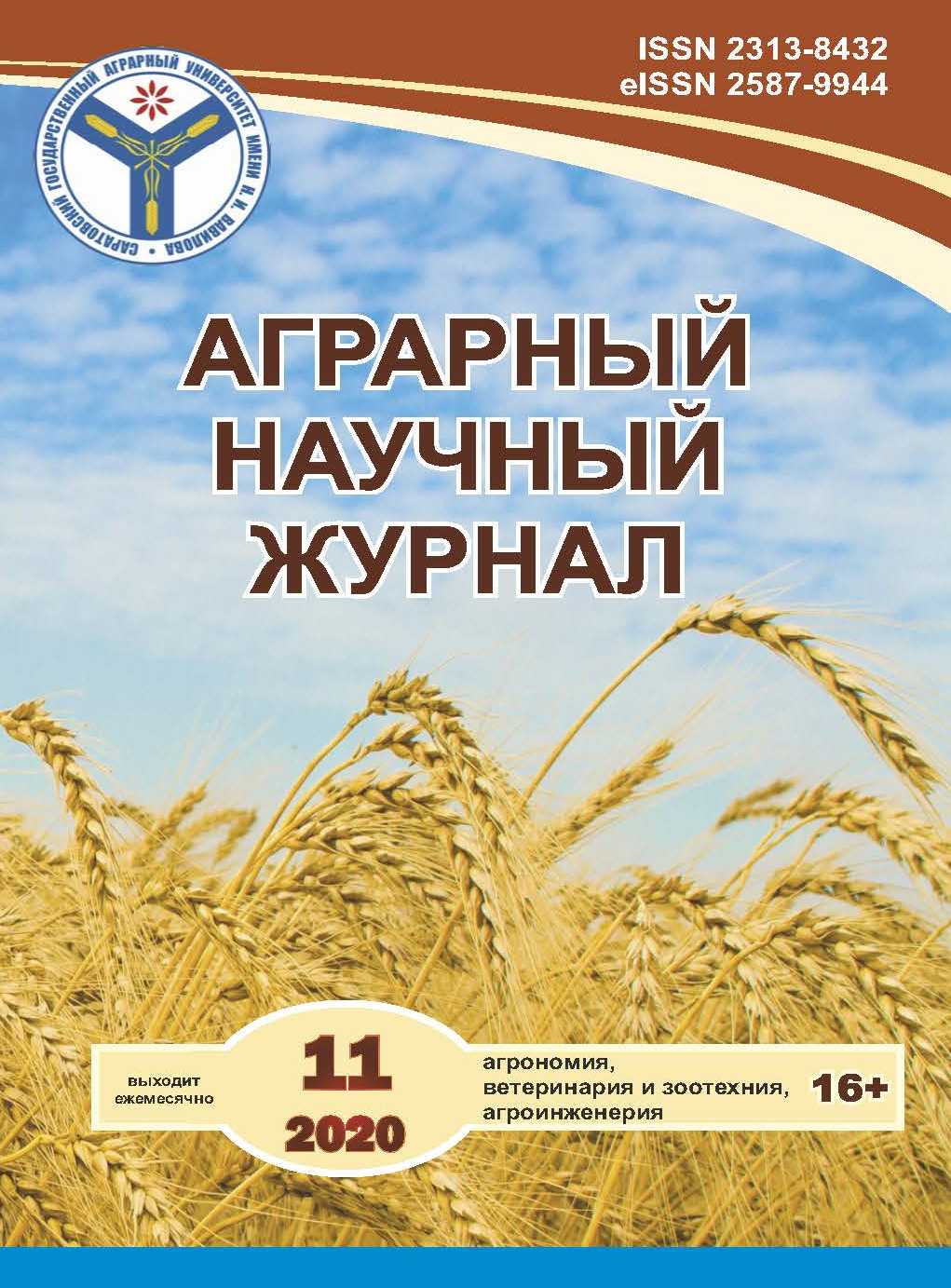Screening of pepper (Capsicum l.) seedlings tolerance to low temperature
DOI:
https://doi.org/10.28983/asj.y2020i11pp78-82Keywords:
genotype, seedlings, temperature, damage, chlorophyllAbstract
This study was conducted on screening for 21 pepper genotypes tolerant to low temperature and their duration for survival in 3-4 (38 days after sowing), and 4-6 (47 days after sowing) true leaf seedling growth stages (LS). It was detected that response of seedlings on low temperature were different and ranged among the genotypes depends on growth stages. Seedlings in early 3-4 LS growth stage were more susceptible than 4-6 LS seedlings, where the first symptoms of leaf cold damages (LCD) were revealed within 7 days after transplanting (DAT) and 12 DAT in pepper seedlings, respectively. There were identified that the susceptible genotypes in 3-4 LS can be tolerant in 4-6 LS, or show opposite pattern, where tolerant one in next the growth stage, plant becomes susceptible. Low temperature negative impact on chlorophyll content (CHL) in leaves, however depends on seedling growth stage and genotype might be ranged. The lowest content of CHL were observed in early growth 3-4 LS seedlings than 4-6 LS. And, it was revealed that cold susceptible pepper genotypes in which CHL reduced significantly during cold treatment, showed good ability to recovery of CHL after treatment of seedlings in NT condition, whereas cold tolerant genotypes with high CHL content during low treatment, can reduce significantly of CHL after transfer of seedlings to NT condition for recovery. According to screening were selected relatively cold tolerant pepper genotypes LT8 and LT9 in early 3-4 LS, and LT8, LT13, LT18, LT20 and LT21 in 4-6 LS, where LCD were below 45 and 10%, respectively.
Downloads
References
Adams S.R., Cockshull K.E., Cave C.R. Effect of temperature on the growth and development of tomato fruits // J. Ann. Bot., 2001, 88:869-877.
Bhandari S.R., Kim Y.H., Lee J.G. Detection of temperature stress using chlorophyll fluorescence parameters and stress-related chlorophyll and proline content in paprika (Capsicum annuum L.) seedlings // J. Horticultural Science and Technology, 2018, 36(5):619-629.
Caesar J. Effect of simulated shade radiation quality on the chlorophyll content of long and short shoot early leaves of birch (Betula pendula Roth.) // J. Photosynthetica, 1989a, 23: 126-129.
Chinnusamy, V., Zhu J.K., Sunkar R.. Gene regulation during cold stress acclimation in plants // Sunkar R. (Ed.). Plant Stress Tolerance, Springer, Heidelberg, 2010, pp. 39–55.
Ding F., Liu B., Zhang Sh. Exogenous melatonin ameliorates cold-induced damage in tomato plants // J. Scientia Hortic, 2017, 219: 264–271.
Erickson A.N., Markhart A.H. Flower developmental stage and organ sensitivity of bell pepper (Capsicum annuum L.) to elevated temperature // J. Plant Cell Environ, 2002, 25:123–130.
Gajanayake B., Trader B.W., Reddy K.R., Harkess R.L. Screening ornamental pepper cultivars for temperature tolerance using pollen and physiological parameters // J. Hortscience, 2011, 46(6):878–884.
Ghorbanpour A., Salimi A. et al. The effect of Trichoderma harzianum in mitigating low temperature stress in tomato (Solanum lycopersicum L.) plants // J. Scientia Hortic, 2018, 230: 134–141.
Hernandez J., Jimenez A., Mullineaux P. Tolerance of pea (Pisum sativum L.) to long-term salt stress is associated with induction of antioxidant defences // J. Plant Cell Environ, 2000, 23: 853–862.
Hu T., Wang Y., Wang Q., Dang N., Wang L., Liu Ch., Zhu J., Zhan X.. The tomato 2-oxoglutarate-dependent dioxygenase gene SlF3HL is critical for chilling stress tolerance // J. Hortic. Res.,2019, 6:45.
Liu H., Ouyang B., Zhang J., Wang T., Li H. et al. Differential modulation of photosynthesis, signaling, and transcriptional regulation between tolerant and sensitive tomato genotypes under cold stress // PLoS ONE, 2012, 7(11): e50785.
Liu H.Y., Wang Z.L., Wang Y.H. Studies on the chilling tolerance of different pepper varieties during germination of seeds and seedling // J. of Shihezi University, 2002, 6: 23–26.
Meng Y., Yan L., Fan Y. Study of low temperature and weak light on change of some electro-physiological index and its correlation with chilling injury index of sweet (hot) pepper seedlings // J. Botanical Research, 2017, 6(5): 333–339.
Munir S., Liu H., Xing Y., Hussain S., Ouyang B., Zhang Y., Li H., Ye Zh. Overexpression of calmodulinlike (ShCML44) stress-responsive gene from Solanum habrochaites enhances tolerance to multiple abiotic stresses // Sci. Rep., 2016, 6: 31772.
Park E., Hong S.J., Lee A.Y., Park J., Cho B.K., Kim G.. Phenotyping of Low-Temperature Stressed Pepper Seedlings Using Infrared Thermography // J. of Biosystems Engineering, 2017, 42(3):163–169.
Pressman E., Shaked R., Firon N. Exposing pepper plants to high day temperatures prevents the adverse low night temperature symptoms // J. Physiol. Plant, 2006, 126:618–626.
Rajametov Sh., Yang E.Y., Cho M.Ch., Chae S.Y., Kim J.H., Nam Ch.W., Chae W.B.. Traits affecting low temperature tolerance in tomato and its application to breeding program // J. Plant Breed. Biotech, 2019, 7 (4): 350–359
Richardson A.D., Duigan S.P., Berlyn G.P. An evaluation of noninvasive methods to estimate foliar chlorophyll content // J. New Phytologist, 2002, 153: 185–194.
Shaked R., Rosenfeld K., Pressman K. The effect of night temperature on carbohydrates metabolism in developing pollen grains of pepper in relation to their number and functioning // J. Sci. Hort., 2004, 102:29–36.
Venema J.H., Posthumus F., M. de Vries, P.R. van Hasselt. Differential response of domestic and wild Lycopersicon species to chilling under low light: growth, carbohydrate content, photosynthesis and the xanthophyll cycle // J. Physiologia Plantarum, 1999, 105: 81–88.
Venema J.H., Linger P., A.W. van Heusden, P.R. van Hasselt, Bru?ggemann W. The inheritance of chilling tolerance in tomato (Lycopersicon spp.) // J. Plant Biology, 2005, 7: 118–130.
Xiaoa F., Yang Z., Zhua L. Low temperature and weak light affect greenhouse tomato growth and fruit quality // J. Plant Sci., 2018, 6(1): 16–24.
Downloads
Published
Issue
Section
License
Copyright (c) 2020 The Agrarian Scientific Journal

This work is licensed under a Creative Commons Attribution-NonCommercial 4.0 International License.








